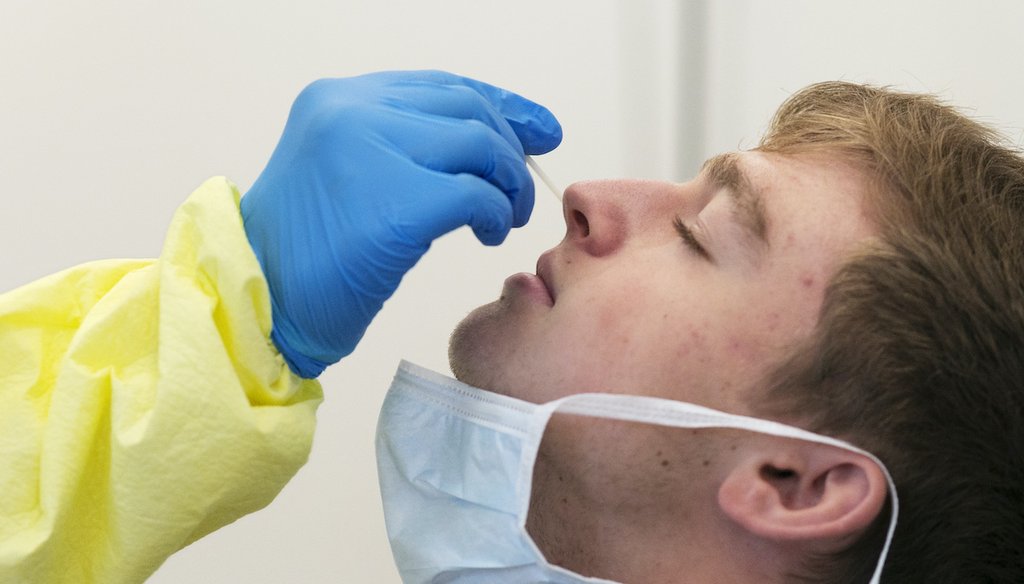



Eric Antosh has a nasal swab taken by a nurse at a COVID-19 testing site in Brooklyn, N.Y., run by NYC Health + Hospitals on July 8, 2020. (AP)
• The swabs used for COVID-19 tests collect samples from the nasopharynx.
• Doctors say the swabs do not go anywhere near the blood-brain barrier.
• There is also no evidence that getting a COVID-19 test could cause anything more serious than temporary irritation.
With 3 million coronavirus cases in the U.S. and counting, tests for COVID-19 are as important as ever. However, the nasal swab tests that determine if a person is actively infected with the virus have become the target of online misinformation.
Social media users are circulating a post that claims the nasal swab tests are unsafe.
"The spot where they are ‘getting a sample’ for the COVID-19 test is called your Blood-Brain Barrier," the post reads.
The post also claims a person could experience a number of other medical complications and conditions after receiving a COVID-19 test if the test compromised the blood-brain barrier. These symptoms include, the post alleges, "autism, ADD, ADHD, heart disease, autoimmune disease, cancer, neurodegenerative disease, stroke, liver damage," and many more.
The post was flagged as part of Facebook’s efforts to combat false news and misinformation on its News Feed. (Read more about our partnership with Facebook.)
There is no evidence to support these claims, and the Associated Press debunked a similar one.
One of the most common COVID-19 tests requires a swab reach "deep inside a person's nose and throat to extract sputum — the gunk that gets ejected through coughing, sneezing, spitting, and even singing," Business Insider reports.
"They have to go deep into the nose, and it’s called the nasopharynx," said Dr. Sandro Cinti, a University of Michigan professor who specializes in infectious diseases.
Typically, a 6-inch nasopharyngeal swab is inserted "into the cavity between the nose and mouth … for 15 seconds" and rotated many times, according to UC Davis Health in California. Once one side of the nose is swabbed, the other side will be swabbed as well.
Cinti explained that cells have to be collected to test for the coronavirus.
"They have to go back there with a swab in order to get adequate cells because viruses live in cells," he said. "So they go back there, and then they have to turn the swab a few times for about 15 seconds, which sounds fast but it’s a lot of time when they’re doing it in your nose."
An article from the University of Texas MD Anderson Cancer Center warns that the test can be uncomfortable and create "a lot of very odd sensations." This includes making a person tear up or potentially triggering a gag reflex.
Getting a COVID-19 nasal test would not cause any serious medical complications. It could cause "temporary irritation," Cinti said.
There is no evidence the swab used to test for COVID-19 could compromise the blood-brain barrier.
"It is uncomfortable," said Cinti. "But it doesn’t go anywhere near the blood brain barrier."
The term blood-brain barrier actually refers to "unique properties" found in the blood vessels that supply blood to the central nervous system, according to an article from the National Center for Biotechnology Information.
The blood-brain barrier’s purpose is to prevent pathogens and toxins in the bloodstream from reaching the brain, while also allowing vital nutrients through.
Endothelial cells line the interior of blood vessels throughout the body, but "in the capillaries that form the blood–brain barrier, endothelial cells are wedged extremely close to each other, forming so-called tight junctions," according to the Queensland Brain Institute.
It is primarily these tightly-packed endothelial cells within the brain’s blood vessels that make up the blood-brain barrier.
It is simply not possible for the nasopharyngeal swabs used in COVID-19 tests to compromise the blood-brain barrier.
"The swab "would have to go through layers of muscle and fascia, as well as the base of the skull, which is a thick bone, in order to get anywhere near the blood-brain barrier, and I would say that it is not possible," Dr. Morgan Katz, an assistant professor of medicine at Johns Hopkins University, told the Associated Press.
A social media post claimed, "The spot where they are ‘getting a sample’ for the Covid-19 test is called your Blood-Brain Barrier." It also went on to claim that after getting a test, a person could develop a number of medical conditions.
The nasal swab COVID-19 tests collect samples from the cavity between the nose and mouth, not the blood-brain barrier.
It would not be possible for the 6-inch nasopharyngeal swabs used in COVID-19 tests to compromise the blood-brain barrier, which refers to the tightly packed cells inside the blood vessels of the brain.
We rate this claim Pants on Fire!
Associated Press, "Test for COVID-19 does not involve collecting a sample from the blood-brain barrier," July 6, 2020
Interview with University of Michigan professor Dr. Sandro Cinti who specializes in infectious diseases, July 8, 2020
NBC News, "U.S. has seen more than 3 million coronavirus cases," July 7, 2020
U.S. Food and Drug Administration, "Coronavirus Testing Basics," accessed July 8, 2020
Business Insider, "Here’s how coronavirus nose and throat swab tests really work, and why they don’t always give satisfying results," April 15, 2020
UC Davis Health, "Coronavirus (COVID-19) testing: What you should know," accessed July 8, 2020
University of Texas MD Anderson Cancer Center, "10 things to know about COVID-19 testing," accessed July 8, 2020
University of Queensland Queensland Brain Institute, "What is the blood-brain barrier?" accessed July 8, 2020
BrainFacts.org, "The Blood-Brain Barrier," July 2, 2014
The National Center for Biotechnology Information, "The Blood–Brain Barrier," published Jan. 2015
In a world of wild talk and fake news, help us stand up for the facts.
